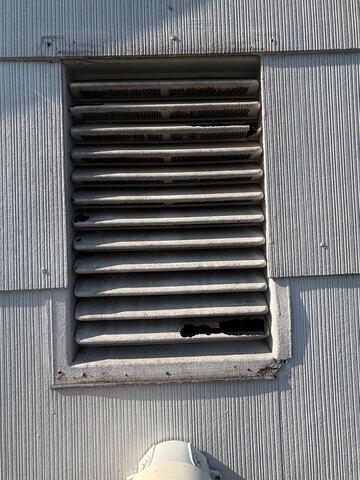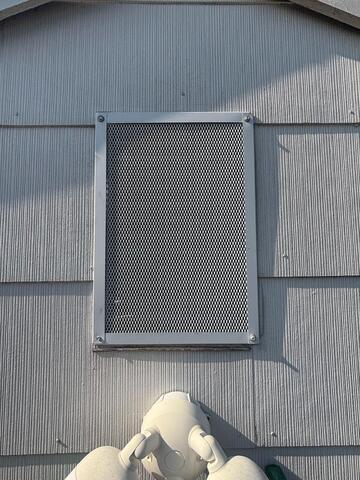Cowleys Pest Services Before & After Photos
Click on a photo to enlarge.
Mice Are Feasting on Our Bait Stations in Lawrence Township, NJ
We returned to this commercial property in Lawrence Township, NJ to check on the mice activity. On our first visit, we had installed several rodent bait stations around the exterior and throughout the interior of the building. We're back to see if there was any activity and we're happy to report, there was! The mice had devoured the bait in several of our bait stations. One even had a mice nest inside of it!
This tells us what areas have the most rodent activity and helps us determine what areas need the most attention. So we're going to replenish the bait in all the bait stations and seal up any and all potential openings that the mice are and may be using to infest the interior of the building. Lastly, we scheduled additional follow up visits to monitor the activity.
Excluding the Gable Vents from Bats in Skillman, NJ
Several bats were entering this home in Skillman, NJ by squeezing through the damaged gable vent. A short time after setting up our retrieval devices, we safely removed all the bats from the property. After disinfecting the area, we went back to our trucks, fashioned a louvered vent guard and installed it over the gable vent.
The louvered vent guard is made out of heavy-duty Galvannealed steel, which means that not only is it durable, but it also won't rust. Additionally, it is customized to accommodate vents of all shapes and sizes and properly secures the area from not just bats, but all nuisance wildlife and birds too.
Dirty drains invite pests in Somerville, NJ
While servicing on one of Cowleys commercial accounts in Somerville, NJ, I noticed that some of the floor drains were quite dirty with accumulated organic matter on the walls of the drains. This “gunk” can easily become a breeding ground for fruit flies, drain flies, and other small gnats.
To treat these potential breeding areas, we use a bio-foam, a bioenzymatic cleaner that continuously breaks down the decaying organic matter, removing a choice breeding habitat for these pests. I applied this product generously to the basket, pipes, and anywhere else that build-up was evident. Going forward, I recommended a stringent cleaning program to prevent this from re-occurring. Often, especially with restaurants, the source of the pest problem is hidden food debris, whether behind appliances or inside drains. A commercial kitchen may superficially look spotless, but once you start doing some digging, you realize that there are many food sources allowing these pests to survive and thrive. Instituting and enforcing sanitation and hygiene protocols can make all the difference.
Sealing an Entry Point for Mice in Somerville, NJ
Recently, I was sent out on a service call to one of the condominium complexes we service in Somerville, NJ for a mice problem. When I arrived, I inspected the interior of the home and found mice droppings in the laundry room and office. I then inspected the exterior of the unit and, within minutes, I was able to find the entry point! There was a giant gap where the utility wires were leading into the home.
I carefully cleaned up all the droppings inside the home, stuffed all the openings with chew-proof stainless steel mesh, and then sealed them in place with a premium, waterproof adhesive. Lastly, I placed several Ready-to-Use rodent bait stations throughout the interior and along the exterior of the building. I'll return for several follow-up visits to monitor the rodent infestation and replenish the bait stations as needed.
Installing Bird Slope to Prevent Birds from Roosting in Gladstone, NJ
This homeowner in Gladstone, NJ was having issues with birds that were nesting on the small ledges by the joists. If not taken care of, the birds will continue to use these areas for nesting year after year
We carefully removed all the nesting debris, disinfected the area, and installed Bird Slope. Bird Slope is a physical bird deterrent used to block birds from landing or nesting on open ledges. Bird Slope's unique angled design makes it impossible for birds to land or nest in 90° areas such as ledges, window sills, or eaves making it an effective bird deterrent against all nuisance birds.









